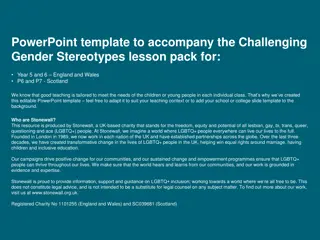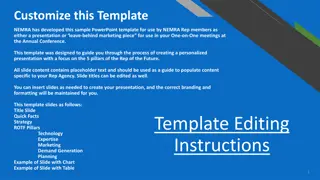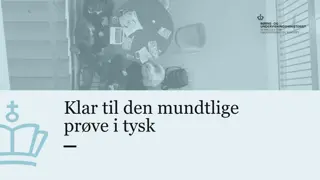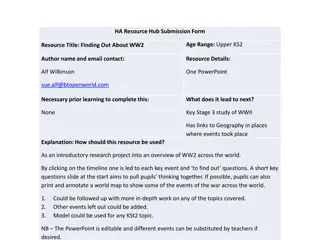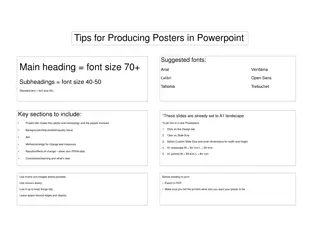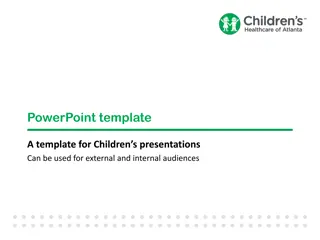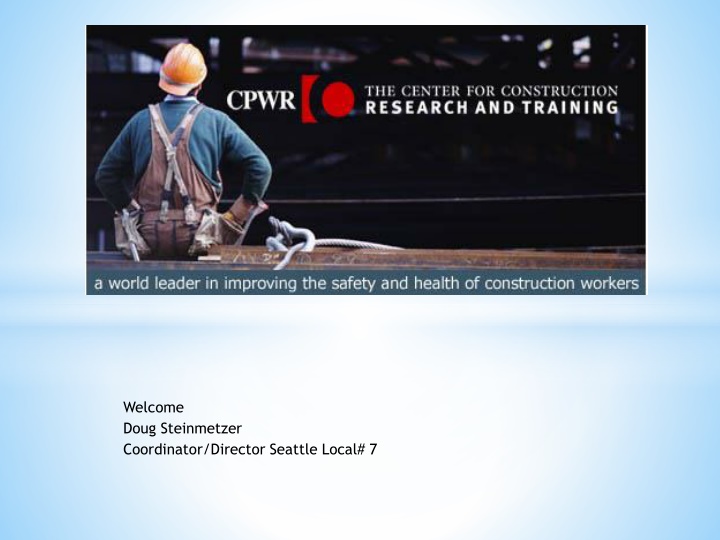
CPWR - Advancing Construction Industry Safety and Health
CPWR, the Center to Protect Worker Rights, was established in 1990 to advance the construction industry's safety and health by addressing hazards, conducting research, and providing training resources. The consortium led by CPWR focuses on occupational safety and health in construction to build a culture of safety industry-wide and reduce workplace injuries and fatalities. Learn about CPWR's mission, impact, and efforts towards creating a safer construction industry.
Download Presentation

Please find below an Image/Link to download the presentation.
The content on the website is provided AS IS for your information and personal use only. It may not be sold, licensed, or shared on other websites without obtaining consent from the author. If you encounter any issues during the download, it is possible that the publisher has removed the file from their server.
You are allowed to download the files provided on this website for personal or commercial use, subject to the condition that they are used lawfully. All files are the property of their respective owners.
The content on the website is provided AS IS for your information and personal use only. It may not be sold, licensed, or shared on other websites without obtaining consent from the author.
E N D
Presentation Transcript
http://www.bctd.org/files/Site-Images/cpwr_photo.aspx Welcome Doug Steinmetzer Coordinator/Director Seattle Local# 7
*What is CPWR? (Center to Protect Worker Rights) *Let s divide into groups of four and take two to three minutes to answer the question. *Pick someone to give us the response.
*About CPWR *Started in 1990 in agreement with NIOSH and the CDC and the International Building trades. *Our Mission: *To Advance the Construction Industry *To encourage the elimination or reduction of hazards for the American Construction Worker *To Publicize results of research findings for those with an interest in construction industry safety and health *To provide training resources and technical services for worksite workers and issues *To conduct research concerning the quality of working conditions
*The Group that started it all! *CPWR has led a consortium of experts at universities, government agencies, unions, and corporations, to help address the issues and find solutions of Safety and Health in the Construction Fields *We have focused on occupational safety and health in construction, with an eye to building a safety culture industry wide *The Research Consortium
*1992 to 2008 Averaged 1160 workers per year were killed by occupational injuries in construction *in 2010, 802 workers were killed by occupational injuries in construction, 17.1% of all workplace deaths more than in any other industry in the United States. Which was during a downturn in the economy. *The levels of lung diseases and cancers from exposures to silica, asbestos, solvents, and other toxics are believed to be high, too, but have been difficult to document because of the time lag from exposure to the appearance of symptoms. *The Research Consortium
*Question how are we going to build an industry wide that is safe and has healthful working conditions along with lowered costs and improved industry productivity? *The Answer; CPWR and its partners sought to identify the most pressing hazards and outcomes, in the form of illnesses, injuries, deaths, and related costs. *The Research Consortium
*As the issues have been better defined, the emphasis has shifted from observing trends to application: defining best practices and helping to implement them. *Through publications such as technical reports and pocket cards for workers and contractors, and on the Internet. *CPWR produces documents focusing on the industry, which details the industry in terms of economics and safety and health incorporated into training materials for use through more than 3,500 safety trainers affiliated with the Building Trades unions. *From Observation to Implementation and Training
*The years since 1990 might be summarized this way: *1990-1994: Define the problem and set a research agenda *1995-1999: Define best practices for the industry *2000-2004: Practical research and dissemination of findings *2005-2009: Intensify targeted research and dissemination *2010-2014: Emphasis on research to practice *From Observation to Implementation and Training
*CPWR Websites; *Information on Hand injuries *CPWR Building trades screening program Stop Construction Falls *More About CPWR
*CPWR Impacts, & Highlights *Research Findings & Technical Publications *key findings from research *cpwr quarterly data reports & data briefs *peer reviewed journal articles *cpwr reports *Materials for Workers *spanish resources *health & safety videos *journeymen technical papers *the construction chart book *articles and industry publications *hazard alerts *handouts & toolbox talks *CPWR Publications
*A recognized world leader in construction safety and health research *CPWR serves as the National Construction Center for the National Institute for Occupational Safety and Health (NIOSH) and through a NIOSH cooperative agreement conducts research to * Understand the hazards facing workers in the construction industry * Develop evidence-based technologies and work practices to prevent occupational injuries and illnesses * Identify emerging hazards and the safety and health implications and protective measures * Publicize research findings and accelerate their use by translating them into practical tools and resources that can be applied on construction sites to protect workers. *CPWR Research
*CPWR Training builds on the existing Building Trades unions and over 2000 JATC programs in all 50 States and Canada. *These programs invest more that 1$billion dollars a year to train union construction workers in construction skills including safety and health. *That s more than 500,000 per year trained with the help of CPWR to reach all sectors of the construction industry. *CPWR TRAINING
*Current CPWR training programs include both instructor and worker training skills for: *Work on EPA Superfund and DOE sites nationwide *Safety and health training in Spanish and English including basic safety, confined space entry, and asbestos and lead abatement *Work on natural and man-made disaster sites; and *Brownfields and minority worker training on life skills, preapprenticeship, and environmental remediation. *CPWR strives to integrate applied research findings into these training programs to assess continual improvement and evaluate the impacts of safety and health training. *CPWR TRAINING
*Other Training programs offered; *Hazard Communication *Smart Mark *Hazardous waste training *Disaster response *Confined space *Train the trainer *Osha education center *Environmental career worker *CPWR TRAINING
*CPWR projects provide services to workers, contractors, construction site owners, researchers, unions, governments, and society. Activities include: * Medical surveillance programs for former construction workers * Claims assistance to workers or survivors who seek compensation under the Energy Employees Compensation Act * Distributing documents and information with the Electronic Library of Construction Occupational Safety and Health (eLCOSH), Construction Solutions, and publications * Providing technical assistance and access to construction information * Serving on technical and consensus organizations and advisory boards to develop best practices and guidelines * Regulatory analysis related to construction industry safety and health * Facilitating research- to- practice or technology- transfer initiatives that improve construction work conditions and prevent injuries * Assisting NIOSH and academic researchers in gaining access to construction sites for applied research to prevent construction injuries and illnesses * Improving construction data acquisition, data assessment, and data sharing *CPWR SERVICE
*In order to prevent deaths, injuries and illnesses in construction, interventions must be evaluated in the workplace and communicated to employers and workers. *Service with the following programs; *Medical screening *Nuclear worker compensation *Tech/ regulatory assistance *Advisory committees *Mi trabajo seguro (Spanish Website) *Also available safety gear, quantitative testing equipment and others for loan for your safety trainings *CPWR SERVICE
*CPWR STARTED IN 1990 BY THE UNION BUILDING TRADES *CPWR s Mission is to advance construction and to encourage the elimination or reduction of hazards *To provide training resources and technical services for worksite workers and issues *To conduct research concerning the quality of working conditions *We learned that an average of about 18% of construction workers killed by workplace deaths more than any other industry. CPWR is working to improve those statistics. *What have we Learned?
*We saw the various Web sites; Smart Mark, Stop Construction Falls, CPWR Building Trades Screening site to name a few. *We looked at some to the Publications such as Hand Tools, Skin Problems, RF Radiation and Nanomaterials (AEROGEL) *We learned of the Research and Finding publications along with Publications for Workers such as; *spanish resources *health & safety videos talks *journeymen technical papers *hazard alerts *handouts & toolbox *What have we Learned?
*CPWR is dedicated to reducing occupational injuries, illnesses and fatalities in the construction industry. Through our research, training, and service programs, we serve the industry in cooperation with key federal and construction industry partners nationwide. *QUESTIONS? *Conclusion

